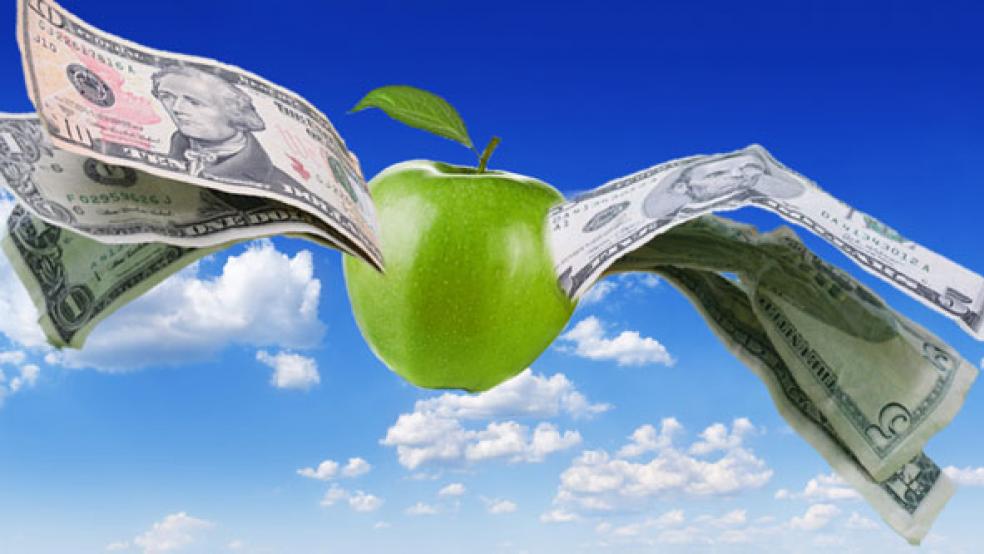Investors’ hunger for dividend stocks just can’t be satisfied. Hardly a day goes by without some financial strategist or other pundit urging them buy to their hearts’ content.
That’s why it was all the more surprising to open up a position paper written by Bob Turner, chairman and CEO of Turner Investments, a Berwyn, Pennsylvania firm with more than $13 billion in assets, reminding us all that there is more to life than dividends. Indeed, he and his team at Turner are growth investors: while they may not be violently opposed to dividends as an article of faith, nor are they about to join the throng banging the table and demanding that Apple start paying out some of its cash hoard to its shareholders as dividends.
Turner admits that corporate America is hoarding its cash, and even compares companies like Apple to compulsive real-life hoarders like those portrayed on reality television. But there, he argues, the comparison breaks down. Corporate hoarders aren’t psychologically dependent on their cash, unable to part with it for any reason. Rather, they may have perfectly sound uses to which they can put that cash, other than paying it back as dividends and, as growth investors, his firm would rather own stocks that are growing by reinvesting surplus cash. “Without a continuing commitment to reinvesting cash in the business, a company can’t develop proprietary new products and services, stay competitive, or remain profitable for long,” he writes.
Both the hunger for dividends and corporate America’s reluctance to dole it out have their roots in the financial crisis and its aftermath. Only yesterday, Federal Reserve policymakers repeated their pledge to keep interest rates at rock-bottom levels until at least 2014. Meanwhile, corporations vividly remember the frozen capital markets after the crisis and don’t want to be held hostage to that kind of event in the future. As a result, corporate profits now represent an astonishing 10 percent of GDP, well above the post-1947 average of about 6 percent.
Other uses for cash include debt reduction – OK, it’s hardly sexy, but as Turner points out, it’s preparing the way for future growth by keeping corporate finances in order – and acquisitions, such as eBay’s purchase of PayPal that was a win-win for both companies. And today’s low-interest rates make it easier to complete such deals by arranging financing.
Turner makes several solid points in his analysis regarding investor attitudes to dividends. Anyone tempted to invest on the basis of a particularly high yield, may find himself or herself owning a stock whose dividend is only high because its stock price is sinking, and that stock price is reflecting lousy earnings or deteriorating demand.
Over-reliance on a portfolio made up of dividend-paying blue chips can lead to underperformance. While the stocks in the Dow Jones Industrial Average were up 6 percent at the end of February, the Nasdaq 100 Index, full of high-growth companies that don’t pay dividends, was up 15.2 percent. Then there’s the prospect that Americans will end up paying much higher taxes on dividends after this fall’s presidential election.
But why not have your cash, and eat it, too? Many companies manage to combine higher growth rates than their peers and still manage to pay dividends. Moreover, because their dividends are relatively modest – for the most case, not exceeding the 1.9 percent yield on the S&P 500 – and their cash positions are solid, they can afford to increase those dividends without compromising that growth.
If Apple is the poster child for Turner’s preference, a company that hangs on to its cash, and rewards investors by generating great growth, Macy’s is the prime example of this alternative approach. The stock has gained 23 percent so far this year, is still trading at only 13.46 times earnings, and the company just doubled its dividend. Overnight, its yield overnight went from about 1 percent to 2 percent.
Macy’s is just one of 60 stocks whose names pop up on a list prepared for Risk/Return by John Kozey, senior analyst of intelligent analytics at Thomson Reuters markets. While Turner says that stocks like Coach, Starbucks, Qualcomm, Monsanto and LuluLemon Athletica have the growth focus that he likes, Kozey’s list is very different, and includes some rather surprising names. The criteria? The company’s existing dividend yield shouldn’t currently exceed the average for the S&P 500 stocks, but its revenues and earnings should be likely to grow at least 20 percent more rapidly than those of its peers -- not only this year but into 2013.
Kozey also used the StarMine earnings quality indicator, a proprietary quantitative model, to winnow out those companies that have question marks hovering about their ability to sustain earnings growth at its current pace over the next year or so. That’s an intriguing combination of qualities, and one that seems to make more sense than either the market’s single-minded pursuit of all dividend stocks, or Turner’s emphasis on growth, even if it comes with a big hoard of idle cash attached.
The companies on this list are an odd assortment, ranging from household names like Visa, Wells Fargo and Goldman Sachs, to lesser-known firms like Danaher, Cummins Inc., and Mckesson Corp. Some of the companies on the list will run afoul of socially conscious investors, including National Oilwell Varco (Haliburton and Baker Hughes, two other energy services companies, also make the cut), and some might quibble at the prospects for Rupert Murdoch’s News Corp, after a fresh wave of arrests in Britain’s phone tapping scandal.
Still, for anyone who’s been wondering what to do about dividends just as Apple’s directors are wondering what to do about their cash mountain, taking a look at this list of companies that seem to have most of the right attributes, without being tilted too much toward one direction or another, seems like a logical place to start.






